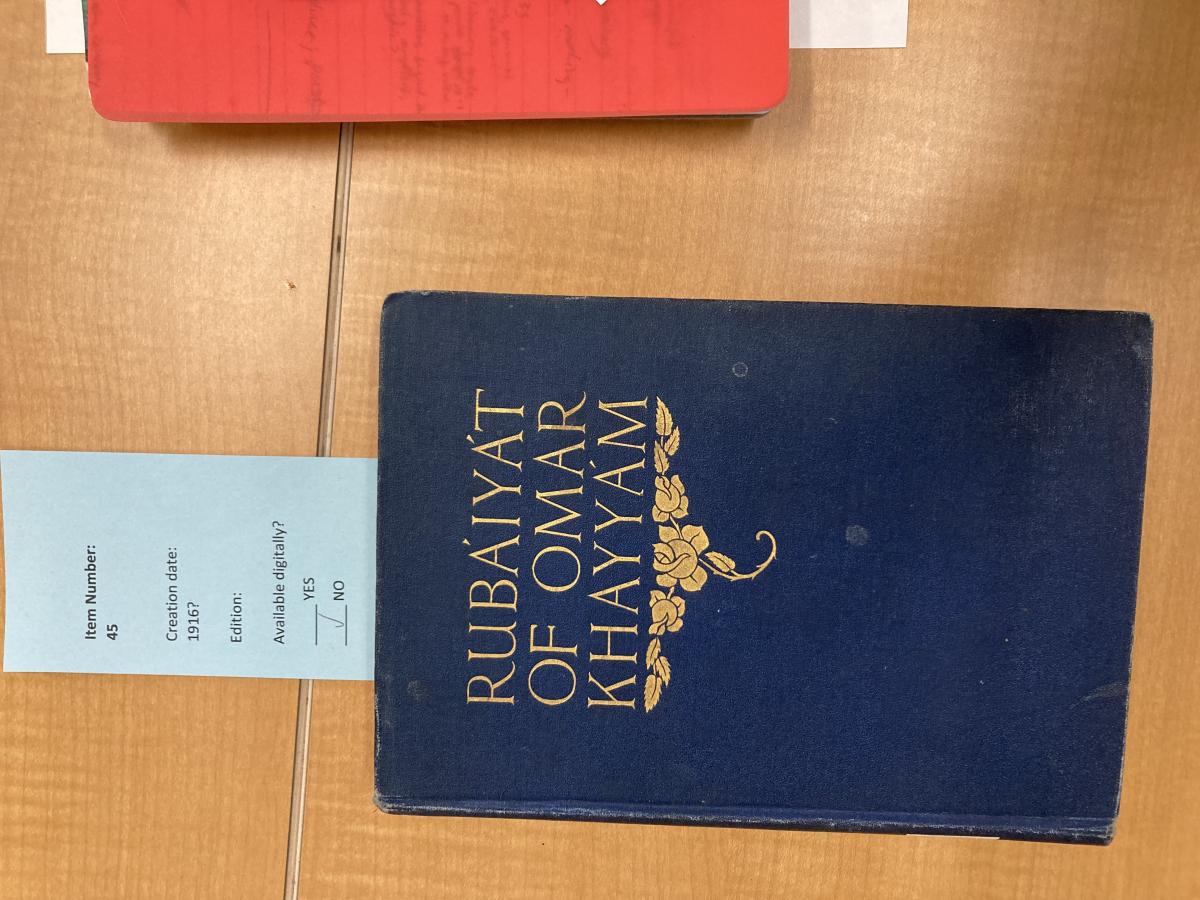Unlike many of its contemporaries within the Sigurd Peterson collection, this edition of Edward FitzGerald’s Rubáiyát of Omar Khayyám is undated, aside from an archival note [See image 1] suggesting a possible creation year of 1916. The gift book’s interior provides little direct evidence of a publication date. An inscription reading ‘Christmas 1922’ found within its front cover [See image 2] provides a partial boundary, while the succinctly scribbled price listing of one dollar could be adjusted for inflation in order to further assess an approximate date range, but without knowing whether this book was sold brand new or aftermarket, any projection would become purely speculative. Beyond what the book makes plainly evident via its visual wear and tear, it is the names contained within - Dr. Reynold A. Nicholson, artist Gilbert James, Hubbell Publishing Company, along with R & R Clark - that hint to a more specific history.
Cross-referencing my search across AbeBooks, Biblio, eBay, and finally, The Antiquarian Booksellers’ Association of America (ABAA), I located an edition released by the same New York Hubbell Publishing Company credited within the collection’s copy. Published in 1900, this edition has an identical exterior, along with illustrations and commentary courtesy of James and Nicholson, respectively. Only, one thing was missing - no mention of the second publishing company hidden deep within my edition’s fine print - R & R Clark Limited. The United Kingdom’s Royal Academy of Arts describes R & R Clark, founded in 1864, as “well-known and highly respected Edinburgh printers used by many prominent London publishers,” but provides no help in explaining the relationship between R & R and Hubbell. Perhaps, the reputation garnered by R & R after thirty-six years in the business had caused their clientele to extend across the pond, with Hubbell simply distributing the previously printed and bound edition to the US.
Getty’s Union List of Artist Names identifies an Englishman named Gilbert James who operated as a painter and illustrator, active from 1886 to 1926. Originating as individual features in newspapers and visual art magazines, James’ illustrations, research provided by the Netherlands’ Utrecht University refers to dozens of distinct editions that James’ gravures, at first black and white and subsequently color, have appeared in (Ghajarjazi). Entrenched, along with the majority of popular Rubáiyát illustrators, within the art nouveau movement, James’ work differs from his peers by achieving narrative continuity. Despite the cliche of his Fez-donning protagonist, James displays an astute understanding of FitzGerald’s mission of assembling disparate quatrains into a cohesive narrative simply by maintaining dress and facial expression across each of his sixteen bookplates. Naturally, it could be argued that James’ perspective was so orientalist that he simply collated the Arabic stereotypes of which he was aware into a consistent embodiment.
The author of aforementioned Utrecht University article, Arash Ghajarjazi, claims that James’ visual rendering of Khayyám’s time implements “icons and symbols [that] are retrieved from familiar percepts in the mainstream Orientalist imagination,” most evident in the oversimplification of the fez and accordance with nudity and decadence. Choosing a set of drawings reflective of how Orientalist or, more specifically, Khayyám clubs conceived of the East accords with the presumed production of this edition for gifting intentions. Additionally, the foreword provided by Dr. Reynold A. Nicholson, referred to in both his own words and the Cambridge alumni database as the foremost expert of his time on Islamic mysticism, adopts a tone intent on affirming its reader that what they hold in their hands is best consumed as an aesthetic pleasure (Cambridge). By virtue of being a self-professed Orientalist, and through the irony of someone completely alien to the lived experience of ‘Islamic mysticism’ being regarded as the keeper of its knowledge, the inclusion of Nicholson’s commentary appears to affirm the proliferation and appreciation of the Rubaiyat as a gift book while granting it academic ‘legitimacy.’
Cambridge University. Reynold Alleyne Nicholson. Retrieved from: https://venn.lib.cam.ac.uk/cgi-bin/search-2018.pl?sur=&suro=w&fir=&firo…
Ghajarjazi, Arash (2023). The Fez-man in Crisis: The Case of Gilbert James. Utrecht University.
Royal Academy. R. and R. Clark (Edinburgh). Retrieved from: https://www.royalacademy.org.uk/art-artists/organisation/r-and-r-clark-…



